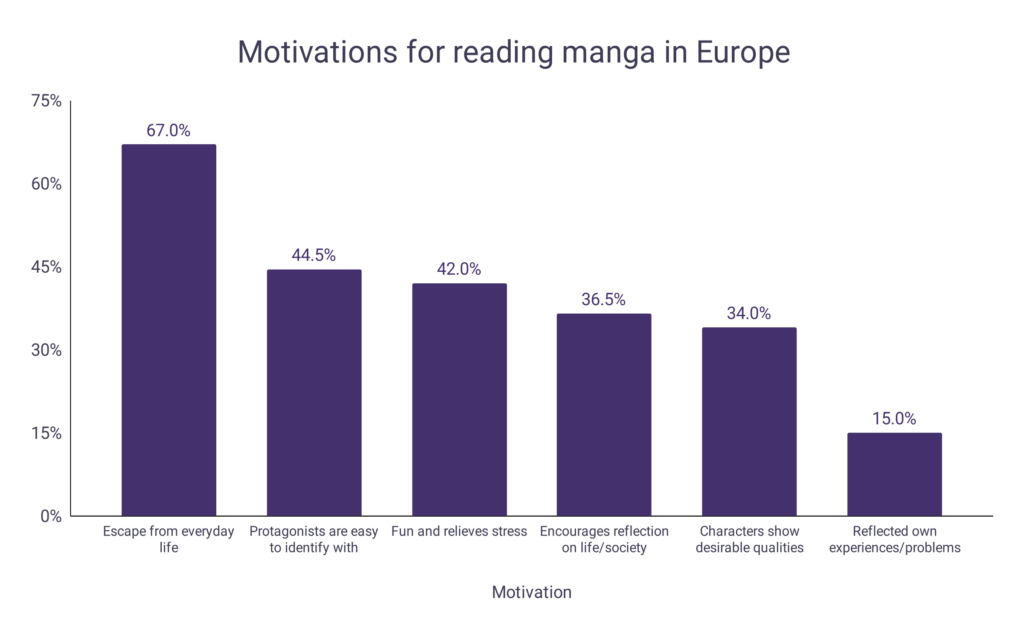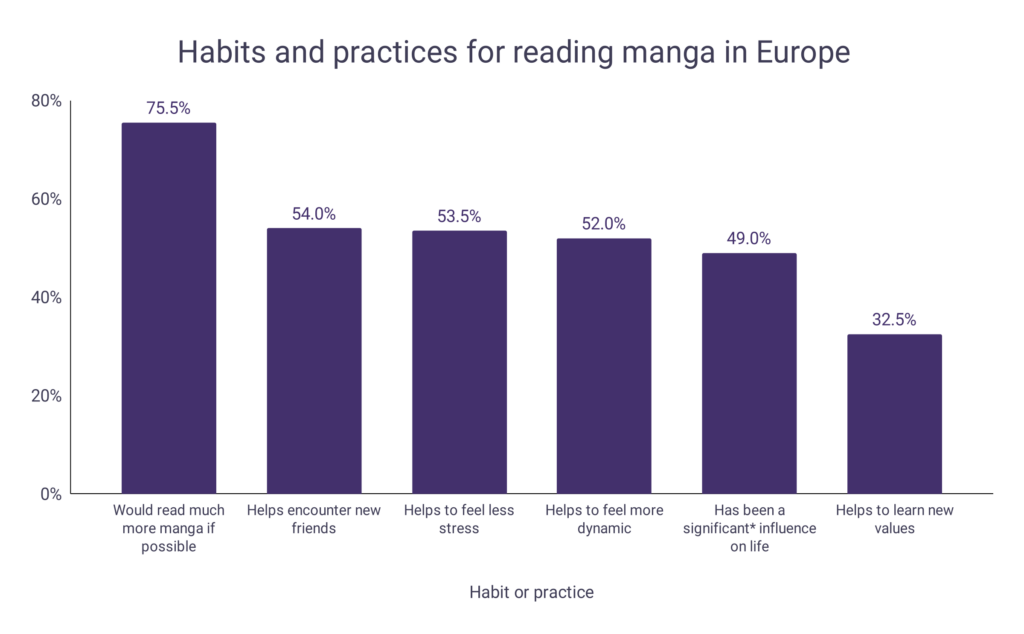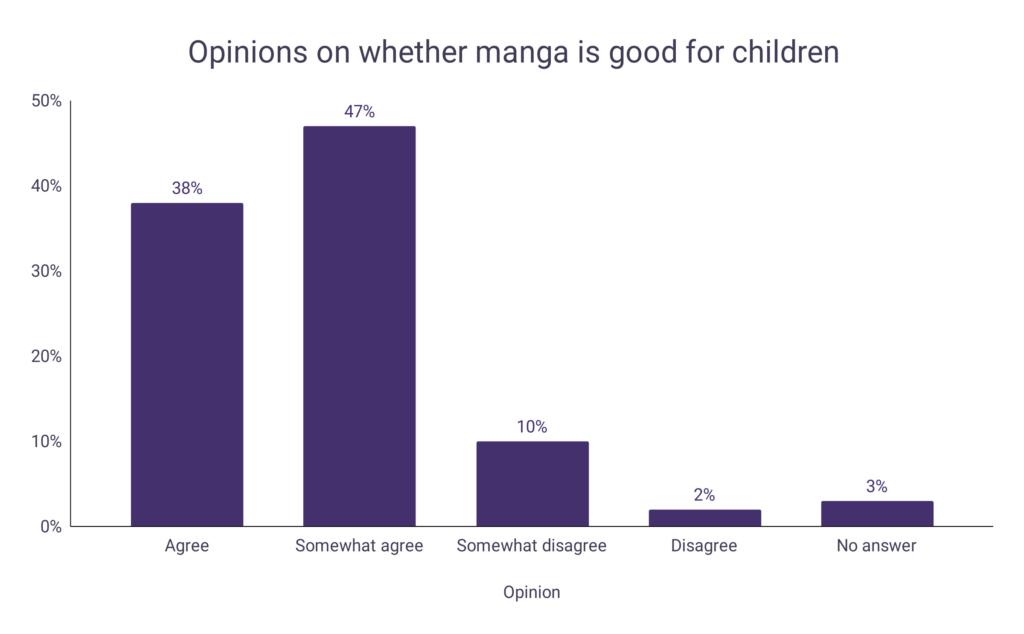Manga provides a visually engaging and highly immersive experience for its readers. As with comic books, manga blends together interesting characters, clever storytelling and unique visuals that appeal to fans all over the world.
Through the medium, readers can delve into different genres, find new perspectives and explore other cultures. When these are combined, they can contribute to the growth of a stronger reading habit overall, that can kickstart and encourage a person’s personal development.
- A Japan-wide survey of all ages found that over 90% of the 49 or younger age group believe reading manga is good for children.
- 63% of respondents of all ages said that manga enriches sensitivity and expressiveness.
- 53% of respondents of all ages said that manga gives children something to talk about with their friends.
- 44% of respondents of all ages said that manga increases knowledge.
- One study showed that 75.5% of international students in Japan initially became interested in learning Japanese due to their interest in manga and anime.
- Manga’s high level of focus on images and visual language can appeal to individuals with Autism Spectrum Disorder (ASD), who may be better at processing images than words.
- The drawings within manga can be especially useful to those with ASD as facial expressions are often exaggerated to simplify emotions for the reader.
- Dyslexic readers can also benefit from manga as pages have less words and more pictures, allowing them to finish pages more quickly and easily than other mediums.
- As manga can more easily maintain their interest, they can be led to finish titles faster and gain confidence in their reading ability.
- Detailed hand-drawn images used in manga can even help readers develop an appreciation of art.
Motivations for reading manga
People can become drawn to read manga for inspiration, entertainment and even social reasons. On the whole, manga’s global availability and large range of titles appeal to people from different backgrounds with a range of interests.
- An analysis of manga readers in Europe found that 67.0% of fans read manga to escape from their everyday life.
- 44.5% read manga as the protagonists are easy for them to identify with.
- 42.0% read manga due to it being fun and a form of stress relief.
| Reason for reading manga | Percentage |
| Escape from everyday life | 67.0% |
| Protagonists are easy to identify with | 44.5% |
| Fun and relieves stress | 42.0% |
| Encourages reflection on life/society | 36.5% |
| Characters show desirable qualities | 34.0% |
| Reflected own experiences/problems | 15.0% |
A graph is given below to show motivations for reading manga in Europe:

Habits and practices for reading manga
For many people, manga reading as part of a healthy lifestyle can provide them with a sense of escapism from the stresses of everyday life. Fans of manga also report a range of other positive associations they have found since developing an interest in the hobby.
- An analysis of manga readers in Europe found that 75.5% of fans would read much more manga if it were possible.
- 54.0% have encountered new friends through manga.
- 53.5% have felt less stress due to manga.
| Habits and practices for reading manga | Percentage |
| Would read much more manga if possible | 75.5% |
| Helps encounter new friends | 54.0% |
| Helps to feel less stress | 53.5% |
| Helps to feel more dynamic | 52.0% |
| Has been a significant* influence on life | 49.0% |
| Helps to learn new values | 32.5% |
A graph is given below to show habits and practices for reading manga in Europe:

Opinions on whether manga is good for children
Whether the benefits of manga outweigh the negatives for child readers is a topic of interest for many parents. Certain types of manga are known to contain adult visuals and themes, so it is very important for parents to help their children choose age-appropriate titles that can aid their growth.
- A Japan-wide survey found that 85% of people at least somewhat agree it is good for children to read manga.
- Of these respondents, 38% said that they fully agreed.
- Just 12% at least somewhat disagreed that it is good for children to read manga.
- Of these respondents, 2% said that they fully disagreed.
| Opinion on whether manga is good for children | Percentage |
| Agree | 38% |
| Somewhat agree | 47% |
| Somewhat disagree | 10% |
| Disagree | 2% |
| No answer | 3% |
A graph is given below to show opinions on whether manga is good for children:

How manga affects learning
Manga can be a valuable educational tool for readers, improving reading comprehension, visual literacy and cultivating an interest in new topics and cultures.
- When compared to traditional book reading, manga requires the reader to utilize a different set of skills, challenging the brain in alternate ways.
- Manga readers must continuously decode pictures in order to understand the plot, enhancing visual literacy (the ability to comprehend and analyze visual information).
- Through the engagement of the reader’s imagination, manga can help readers learn words, phrases and idioms in a more enjoyable way.
- The combination of graphics and text alone can help the reader to interpret unknown words.
- Readers of manga can find it more fun and easy to read than other types of publications, which encourages reading and boosts its popularity.
- When compared to watching anime, readers are able to easily read manga on-the-move, giving readers a great advantage when it comes to its portability.
Benefits of reading manga FAQ
What is manga?
- Originally from Japan, manga are variations of comic books and graphic novels that are now hugely popular around the world.
- They are known for featuring a unique style of art which shows exaggerated facial expressions/features with stunning background scenery.
- Manga has many different genres to appeal to all types of readers, such as action, fantasy, romance and horror.
What does manga mean?
- From Japanese, the word manga (漫画) translates to “whimsical pictures” or “comics” in English.
- Over time, this has developed to encompass diverse genres and themes, through its form of illustrated storytelling.
- The medium can be serialized through comics and magazines that are compiled into different volumes.
How to read manga panels?
When reading manga, readers should pay attention to speech bubbles, sound effects and visual cues to understand the order and nature of the scene. Typically, manga follows the traditional Japanese reading direction (right to left). Each panel is designed to guide the reader naturally through the narrative. Here’s how to do it:
- On the top row, readers should progress from the top right to the top left of the page.
- Move to the next row, and read from right to left again.
- Continue step 2 until you reach the bottom left hand corner of the page.
- Turn to the next page to the left and begin again at step 1.

